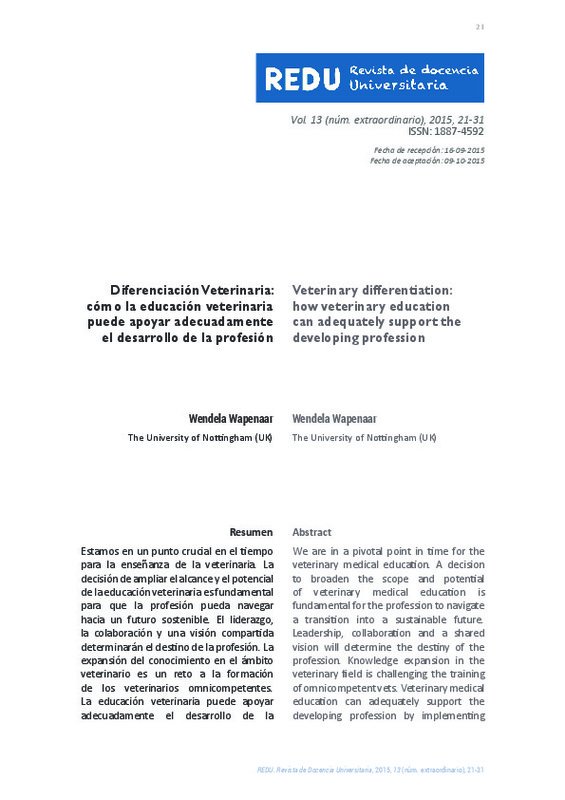AVMA (1993). Membership Directory and Resource Manual. Schaumburg, Il.: American Veterinary Medical Association, 22-26.
Brakke Consulting (2011). Bayer/Brakke study reveals gaps in perception of veterinary care between vets and pet owners. Retrieved from: http://www.brakkeconsulting.com/news_article/665.aspx
Buzzeo, J., Robinson D., Williams, M. (2014). The 2014 RCVS survey of the veterinary profession. Institute for Employment Studies.
[+]
AVMA (1993). Membership Directory and Resource Manual. Schaumburg, Il.: American Veterinary Medical Association, 22-26.
Brakke Consulting (2011). Bayer/Brakke study reveals gaps in perception of veterinary care between vets and pet owners. Retrieved from: http://www.brakkeconsulting.com/news_article/665.aspx
Buzzeo, J., Robinson D., Williams, M. (2014). The 2014 RCVS survey of the veterinary profession. Institute for Employment Studies.
Burns, K. (2013). AAHA president sees uncertainty for profession. Journal of the American Veterinary Medical Association, 242(10), 1329.
BVA1 (2015). Vet futures: Report of the survey of the BVA 'Voice of the profession' panel. Retrieved from: http://vetfutures.org.uk/download/surveys-filebase/Vet%20Futures%20-%20report%20of%20the%20BVA%20Panel%20Survey%20June%202015.pdf
BVA2 (2015). Vet futures: Getting the conversation started. Report of the qualitative research. Retrieved from: http://vetfutures.org.uk/download/reports/Getting%20the%20conversation%20started.pdf
ESEVTn (2009). List of recommended essential competences at graduation: 'Day One Skills'. Retrieved from: http://www.eaeve.org/fileadmin/downloads/sop/SOP_Annex4to8_Hanover09.pdf
Field, V. (2011). Proactive approaches to stress in the veterinary workplace. Veterinary Ireland Journal, 64(2), 84
FVE (2014). Policy paper on veterinary education- Federation of Veterinarians of Europe - FVE. Retrieved from: http://www.fve.org/uploads/publications/docs/008_fve_edu_policy_ga_22_nov_2014_adopted.pdf
Lowe, P. (2009). Unlockingpotential: a report on veterinary expertise in food animal production. London: Vets and Veterinary Steering Group.
MG&A (2014). 24/7: Expectations of the public.
Pattison, I. (1983). The British Veterinary Profession 1791-1948. London: JA Allen.
Platt, B., Hawton, K., Simkin, S., Mellanby, R. (2012). Suicidal behaviour and psychosocial problems in veterinary surgeons: a systematic review. Soc. Psychiatry Psychiatr. Epidemiol., 47(2), 223-240. https://doi.org/10.1007/s00127-010-0328-6
Pritchard, W.R. (1994). A Changing World and a Changing Profession Challenge. Journal of Veterinary Medical Education, 21(2).
RCVS Facts (2014). Facts and figures from the Royal College of Veterinary Surgeons. Retrieved from: http://www.rcvs.org.uk/publications/rcvs-facts-2014
Roberts, S., Jaremin, B., Lloyd, K. (2013). High-risk occupations for suicide. Psychol. Med., 43(6), 1231-1240. https://doi.org/10.1017/S0033291712002024
Robinson, D., Buzzeo, J. (2013). RCVS survey of recent graduates. The Institute of Employment Studies.
Shepherd, A.J., Pikel, L. (2012). Employment, starting salaries, and educational indebtedness of year-2012 graduates of US veterinary medical colleges. Journal of the American Veterinary Medical Association, 241(7), 890-894. https://doi.org/10.2460/javma.241.7.890
Smithcors, J.F. (1957). The Evolution of the Veterinary Art. Kansas City: Vet. Med. Pub. Co.
Veterinary Record (2014). Pet ownership in the UK: where do we stand in 2013. Veterinary Record, 174(3).
Willis, N.G., Monroe., F.A., Potworowski, A., Halbert, G., Evans, B.R., Smith, J.E., Andrews, K.J., Spring, L., Bradbrook, A. (2007). Envisioning the future of veterinary medical education: the Association of American Veterinary Medical Colleges Foresight Project, final report. Journal of Veterinary Medical Education 34(1), 1-41. https://doi.org/10.3138/jvme.34.1.1
Wrigley, N., Lambiri, D. (2014). High street performance and evolution: a brief guide to the evidence. University of Southampton. Retrieved from: http://thegreatbritishhighstreet.co.uk/pdf/GBHS-HighStreetReport.pdf
[-]








